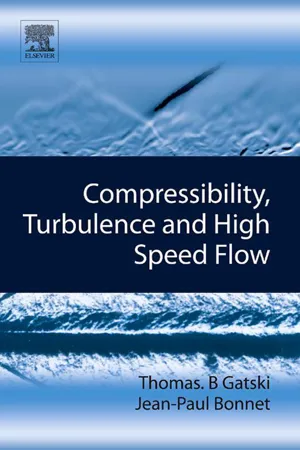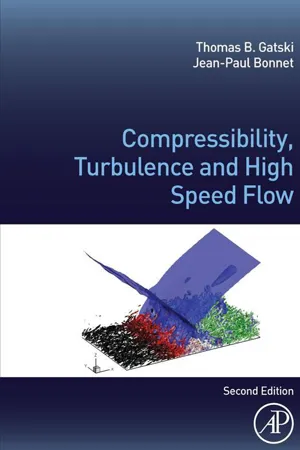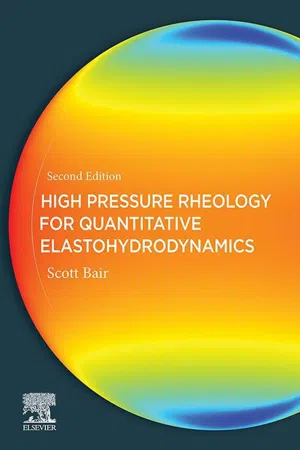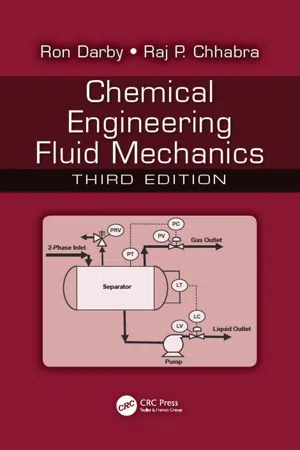Technology & Engineering
Compressible Fluid
A compressible fluid is a substance, such as gas or vapor, that can be compressed or expanded. Unlike incompressible fluids like water, compressible fluids change in density when subjected to pressure variations. This property is important in various engineering applications, such as in the design of gas turbines, aircraft engines, and pneumatic systems.
Written by Perlego with AI-assistance
Related key terms
Related key terms
1 of 4
Related key terms
1 of 3
5 Key excerpts on "Compressible Fluid"
- eBook - ePub
- Thomas B. Gatski, Jean-Paul Bonnet(Authors)
- 2009(Publication Date)
- Elsevier Science(Publisher)
Chapter 1
Kinematics, thermodynamics and fluid transport properties
Compressible Fluid flows have long been a topic of study in the fluid dynamics community. Whether in engineering or geophysical flows, there is probably some mass density change in any physical flow. Many flow situations do exist, however, where such changes can be neglected and the flow considered incompressible. In naturally occurring atmospheric and oceanographic flows, that is geophysical flows, mass density changes are neglected in the mass conservation equation and the velocity field is taken as solenoidal, but are accounted for in the momentum and energy balances. In engineering flows, mass density changes are not neglected in the mass balance and, in addition, are Compressible flow kept in the momentum and energy balances. Underlying the discussion of the fluid dynamics of compressible flows is the need to invoke the concepts of thermodynamics and exploit the relations between such quantities as mass density, pressure and temperature. Such relations, though strictly valid under mechanical and thermal equilibrium conditions, have been found to apply equally well in moving fluids apparently far from the equilibrium state.Turbulence and turbulent fluid flows have been the focus of research for over 100 years, and whose complete solution still eludes engineers and scientists. In the earlier part of the last century, many theoretical and experimental studies were made involving incompressible turbulence and flows; however, the understanding of even the incompressible problem was incomplete, and the analyses constrained by the techniques available at the time. The study of compressible turbulence and compressible turbulent flows thus merge together two topical areas of fluid dynamics that have been thoroughly investigated but yet remain elusive to complete prediction and control. - eBook - ePub
- Thomas B. Gatski, Jean-Paul Bonnet(Authors)
- 2013(Publication Date)
- Academic Press(Publisher)
Chapter 1 Kinematics, Thermodynamics and Fluid Transport PropertiesCompressible Fluid flows have long been a topic of study in the fluid dynamics community. Whether in engineering or geophysical flows, there is probably some mass density change in any physical flow. Many flow situations do exist, however, where such changes can be neglected and the flow considered incompressible. In naturally occurring atmospheric and oceanographic flows, that is geophysical flows, mass density changes are neglected in the mass conservation equation and the velocity field is taken as solenoidal, but are accounted for in the momentum and energy balances. In engineering flows, mass density changes are not neglected in the mass balance and, in addition, are kept in the momentum and energy balances. Underlying the discussion of the fluid dynamics of compressible flows is the need to invoke the concepts of thermodynamics and exploit the relations between such quantities as mass density, pressure, and temperature. Such relations, though strictly valid under mechanical and thermal equilibrium conditions, have been found to apply equally well in moving fluids apparently far from the equilibrium state.Turbulence and turbulent fluid flows have been the focus of research for over 100 years, but complete understanding still eludes engineers and scientists. In the earlier part of the last century, many theoretical and experimental studies were done involving incompressible turbulence and flows; however, the understanding of even the incompressible problem was incomplete, and the analyses constrained by the techniques available at the time. The study of compressible turbulence and compressible turbulent flows thus merge together two topical areas of fluid dynamics that have been thoroughly investigated but yet remain elusive to complete prediction and control. - Scott S. Bair(Author)
- 2019(Publication Date)
- Elsevier(Publisher)
Chapter FourCompressibility and the Equation of State
Abstract
For most engineering applications, liquids are treated as incompressible. Elastohydrodynamics is not a typical engineering application as the pressures are sufficiently large to result in significant increases in density of the liquids. In fact, the pressure dependences of the thermophysical properties of these liquids can often best be correlated with the temperature and density. The simple dilatometer, in which a piston is driven into a cylinder containing liquid, is sufficient for detecting phase changes; however, this approach cannot accurately produce the equation of state which the most precise viscosity correlations require. Relative volume data are provided for some lubricants and well-defined pure liquids and an equation of state is offered for simulations to replace the less accurate universal form in use today.Keywords
Pressure–volume–temperature; refractive index; compressibility; bulk modulus; dilatometer; thermal expansivity; bellows piezometer; refractometer; longitudinal sound velocity; equation of state4.1 Background
For most engineering applications, liquids are treated as incompressible. In acoustics and low-pressure hydraulics, where the compressibility is certainly important, the compression,, may be regarded as linear with pressure and very small relative to the ambient pressure volume,V 0− VV 0. Elastohydrodynamic lubrication (EHL) is quite different from these examples in the magnitude of pressure and the relative compression involved. A liquid lubricant pressurized to 1 GPa at 0°C may experience a relative compression,(, of 20% and at 200°C of 30%. The compression is very nonlinear for EHL pressures. The first half of the compression at 1 GPa comes at a pressure of 1/3 GPa at 0°C and at only 1/4 GPa at 200°C. Here and throughout this book, the distinction betweenV 0− V ) /V 0p = 0 and p = 1 atmosphere- eBook - ePub
From Deep Sea to Laboratory 3
From Tait's Work on the Compressibility of Seawater to Equations-of-State for Liquids
- Frederic Aitken, Jean-Numa Foulc(Authors)
- 2019(Publication Date)
- Wiley-ISTE(Publisher)
1.2. Concepts of compressibilityCompressibility is a general property of a material that causes anything to reduce its volume under the effect of pressure. This property is characterized by coefficients that can be different depending on the material concerned (gas, liquid or solid). In the case of a liquid (usually a state of matter that cannot withstand static shear stress without flow), the only modulus that can be defined is its modulus of elasticity in volume κ, also called the tangent modulus in volume.A specific volume V of liquid that is subjected to a hydrostatic pressure variation ΔP = P – P0 (P is the applied pressure and P0 the reference pressure) undergoes a volume decrease equal to ΔV; its deformation in volume is: -ΔV/V. The modulus of elasticity in volume is then, by definition:[1.3]The reference pressure P0 is often taken as 1 atmosphere. In practice, since the pressures applied to measure the compressibility of liquids are much higher than 1 atm, the pressure variation is considered to be equal to the pressure applied (i.e. ΔP = P).The value of the module κ depends on the speed at which pressure variations occur. If the pressure is applied slowly, the liquid will remain at a constant temperature and, under these conditions, we will have an isothermal module κT . If the pressure variations are so rapid that there can be practically no heat exchange between the liquid and its environment, then we will have an adiabatic module κS - eBook - ePub
- Ron Darby, Raj P. Chhabra(Authors)
- 2016(Publication Date)
- CRC Press(Publisher)
9 Compressible Flows“Surely it is not knowledge, but learning; not owning but earning; not being there, but getting there; that gives us the greatest pleasure.”—Carl Friedrich Gauss, 1777–1855, Mathematician and PhysicistI. GAS PROPERTIESThe main difference between the flow behavior of incompressible and Compressible Fluids, and the equations that govern them, is the effect of variable density, for example, the dependence of density upon pressure and temperature. At low velocities (relative to the speed of sound), relative changes in pressure and associated effects on density are often small and the assumption of incompressible flow with a constant (average) density may be reasonable. It is when the gas velocity approaches the speed at which a pressure wave propagates (i.e., the speed of sound) that the effects of compressibility become the most significant. It is this condition of high-speed gas flow (“fast gas”) that is of greatest concern to us here.A. IDEAL GASAll gases are “nonideal” in that there are conditions under which the density of the gas may not be accurately represented by the ideal gas law:ρ =P MR T(9.1) However, there are also conditions under which this law provides a very good representation of the density for virtually any gas. In general, the higher the temperature and the lower the pressure relative to the critical temperature and pressure of the gas, the better the ideal gas law represents gas properties. For example, the critical conditions for CO2 are 304 K, 72.9 atm, whereas for N2 they are 126 K, 33.5 atm. Thus, at normal atmospheric conditions (300 K, 1 atm), N2 can be described very accurately by the ideal gas law, whereas CO2 deviates significantly from this law under such conditions. This is readily discernible from the P–H diagrams for the substance (see, e.g., Appendix D ), because ideal gas behavior can be identified with the conditions under which the enthalpy is independent of pressure, that is, the constant temperature lines on the P–H diagram are vertical (see Section III.B of Chapter 5
Index pages curate the most relevant extracts from our library of academic textbooks. They’ve been created using an in-house natural language model (NLM), each adding context and meaning to key research topics.
Explore more topic indexes
Explore more topic indexes
1 of 6
Explore more topic indexes
1 of 4




